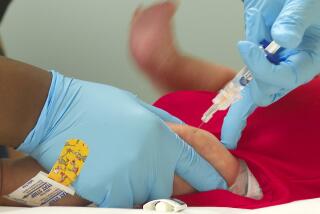Swine flu more deadly to adolescents than to younger children, officials say
- Share via
Adolescents are at higher risk of dying from the pandemic H1N1 influenza virus than younger children, a situation that is the opposite of that encountered with seasonal flu, health authorities said Thursday.
And those with underlying health problems, such as cerebral palsy, muscular dystrophy and neurodevelopmental disorders, are at the highest risk and should be among the first to be vaccinated against the new virus, according to the report in the Centers for Disease Control and Prevention’s Morbidity and Mortality Weekly Report.
The government’s warning takes on added urgency as schools reopen and an increase in infections from the virus, commonly known as swine flu, becomes apparent. Swine flu outbreaks are already occurring throughout the country, especially in the Southeast.
“The most likely explanation is that schools started earlier there,” said Dr. Thomas R. Frieden, director of the CDC.
In a separate report, the American College Health Assn. said there were 1,640 swine flu cases during the week of Aug. 22-28 at the 165 universities reporting to it. There was only one hospitalization, however, and no deaths.
From the time the swine flu pandemic began in April until Aug. 8, 36 U.S. children and adolescents died with laboratory-confirmed swine flu infections, out of a total of 477 deaths in the nation linked to the virus. Seven deaths were of children younger than 5.
In a normal flu season, at least half of the deaths among children occur in those younger than 5. With swine flu, more than 80% of the fatalities occurred in children ages 5 to 18. A typical seasonal flu kills 50 to 100 children. The swine flu deaths occurred after the normal seasonal flu outbreak was over.
Of the 36 children who died, 24 had high-risk medical conditions such as cerebral palsy or long-standing respiratory or cardiac conditions. Many of those who did not have such a medical condition had a bacterial infection, such as bacterial pneumonia, according to the report.
“When you get the flu, your immune system can become weakened and you are more susceptible to other infections,” Frieden said.
The findings emphasize the need for high-risk groups to be immunized against bacterial pneumonia to prevent some of the complications of flu, he said.
The CDC is urging the vast majority of people with flu symptoms to avoid going to doctors or hospital emergency rooms to prevent the facilities from being swamped.
“The overwhelming majority of people [with H1N1 flu] are going to do fine,” Frieden said. “They don’t need testing. They don’t need treatment.”
But children and adults with underlying medical conditions, as well as pregnant women, should seek treatment when a fever from the flu develops. And early treatment is best because antiviral drugs such as Tamiflu are most effective when given in the early stages of the infection.
The government is still on track to have a swine flu vaccine available by mid-October, Frieden noted.
Health authorities have gotten some good news from trials of vaccines in China and Britain. Swiss drug maker Novartis said preliminary results from its trial of one vaccine in Britain showed that 80% immunity was achieved with only one dose of vaccine and that 90% was achieved with two.
Most authorities have thought that two doses of swine flu vaccine will be required to produce adequate immunity, but the new findings suggest that if a shortage of vaccine occurs, one dose might suffice. A separate dose of seasonal flu vaccine will also be required.
The Novartis vaccine cannot be used in the United States, however, because it contains an adjuvant that boosts the immune response to the flu antigens. Flu vaccines containing adjuvants have not been licensed in the U.S.
Beijing manufacturer Sinovac Biotech, which makes a vaccine very similar to that being tested in the U.S., said this week that it had also obtained good immunity with one dose.
The first results from U.S. vaccine tests are expected in a couple of weeks.
--
More to Read
Sign up for Essential California
The most important California stories and recommendations in your inbox every morning.
You may occasionally receive promotional content from the Los Angeles Times.












